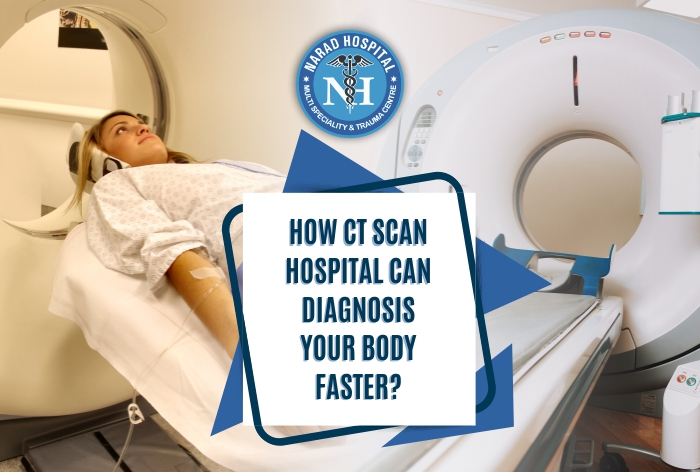CT (Computed Tomography) Scan is reliable for the detection of various diseases and conditions by sophisticated x-ray technology.
The process of CT scanning is fast, painless, and noninvasive and reports are accurate. As compared to traditional x-rays, CT images provide excellent detail of internal organs, soft tissue, bones, and blood vessels.
CT scan is reliable to detect problems like Cardiovascular Disease, Infectious Disease, Appendicitis. Also, you examine for Cancer, Musculoskeletal Disorders and Trauma by it. It can be life-saving for patients in Trauma by helping doctors to evaluate internal injuries and bleeding quickly. To create and interpret CT scans of the body, we require the expertise of radiologists.
According to a survey, about 72 million people in the United States underwent a CT scan during the year 2007, whereas about 80 million in the year 2015.
We regularly diagnose patients suffering from various problems at our CT scan hospital.
HOW DOES A CT SCAN OF YOUR BODY WORKS?
Working similar to x-rays, while CT scans, you have absorption of x-rays in different amounts by your body parts. Varied absorption of x-rays aids your doctor to distinguish body parts on an x-ray sheet or CT image.
During CT scanning, your body has rotating several x-ray beams and electronic x-ray detectors around it. By such, you can measure the amount of radiation-absorbing throughout your body. While some scans, the x-ray beam follows a spiral path due to a movement of the exam table.
CT scan uses a particular computer program to create two-dimensional cross-sectional images of your body by processing this large volume of data. Later, a monitor displays images to you. Sometimes, CT imaging is comparable to a loaf of bread. Computer software reassembles the image slices to give you a multi-dimensional view of your body’s interior in detail.
CT scanners obtain multiple slices in a single rotation as they use refinements in detector technology. It is possible to get thinner slices in a shorter time by multislice or multidetector CT.
Nowadays, we are available with Modern CT scanners that are reliable to scan large sections of the body in very little time at trauma centre hospital. In the case of children, it merely takes a few seconds for scanning though this high speed benefits all patients whether children, the elderly or critically ill.
CT scanner adjusts its technique according to the size and the area of interest while scanning children for reducing the radiation dose.
Sometimes, to get a better view of the area of study, the radiologist can use contrast material.
WHAT STEPS CT SCAN OF YOUR BODY INVOLVES?
First of all, the technologist positions you right on the CT exam table by making you lye flat on the bed. You may get straps and pillows for maintaining the right position while remaining still during the CT exam.
Note: Mostly, scanning for children is faster without sedation. Children may require sedation if they cannot hold still. Movement while scanning can cause blurring of images to degrade the quality of photographs.
Next, to determine the correct starting position for scans, the table quickly moves through the scanner. During the process of a CT scan , your table moves slowly through the machine. You may go through several passes depending upon the type of CT scan.
On completion of the exam, a technologist will ask you to wait for checking the quality of images for interpreting accurately.
Typically, it takes about 30 minutes for CT examination to complete. The portion for which the patient gets intravenous contrast injection lasts only 10 to 30 seconds.
What can you experience during and after CT scanning of your body?
Patients do not feel any pain while CT scan and process is easy and fast. Also, patients have reduced time to lie still with multidetector CT.
Though its time has reduced remaining still for several minutes or placement of an IV can give you some discomfort. You can experience stress while examination, If anxious, having pain or difficulty to remain still. In such a case, you may get direction or medication by technologist or nurse to tolerate the CT exam.
You can feel a pinprick on the insertion of a needle into your vein when using intravenous contrast material. It also gives you a feeling of warmness and a metallic taste in your mouth. After a test, you may require to urinate.
If you are swallowing the contrast material, it can give unpleasant taste in your mouth. However, most patients can easily tolerate it.
If you get contrast material by enema, you can expect to experience an increasing need to expel the liquid and sense of abdominal fullness. Maintain your composure as discomfort will last for little time.
Narad Hospital – Leading CT scan hospital.
Narad hospital is a best CT scan hospital in Hoshiarpur, offering diagnoses by advanced CT scan for various illnesses.
Other than in house CT scan facility, here you get sufficient amenities like x-ray unit and general laboratory for investigation.
Radiologists and technicians are proficient and veteran to carry out your CT examination properly for accurate reports.
For your diagnosis, we follow proper procedures before the CT scan of the patient to ensure examination successful without any discomfort.
Our CT scan hospital is reliable for diagnoses of Infectious Disease, Appendicitis, Cardiovascular Disease. Even you get diagnoses for Cancer, Musculoskeletal Disorders and Trauma.
If you need a CT scan examination for any reason, visit our CT scan hospital, we provide accurate diagnose by most advanced technology.


